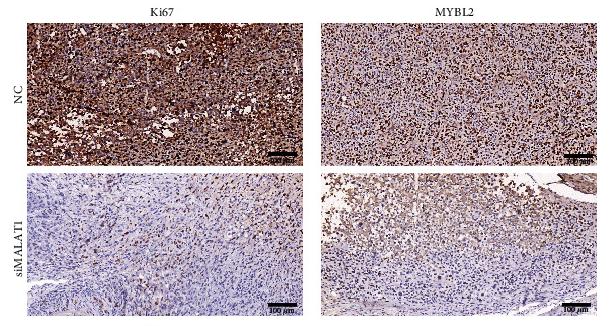B-Myb Antibody - #DF7817
| Product: | B-Myb Antibody |
| Catalog: | DF7817 |
| Description: | Rabbit polyclonal antibody to B-Myb |
| Application: | WB IHC |
| Cited expt.: | WB, IHC |
| Reactivity: | Human, Mouse |
| Prediction: | Pig, Bovine, Horse, Sheep, Rabbit, Dog, Chicken, Xenopus |
| Mol.Wt.: | 79kDa; 79kD(Calculated). |
| Uniprot: | P10244 |
| RRID: | AB_2841266 |
Related Downloads
Protocols
Product Info
*The optimal dilutions should be determined by the end user. For optimal experimental results, antibody reuse is not recommended.
*Tips:
WB: For western blot detection of denatured protein samples. IHC: For immunohistochemical detection of paraffin sections (IHC-p) or frozen sections (IHC-f) of tissue samples. IF/ICC: For immunofluorescence detection of cell samples. ELISA(peptide): For ELISA detection of antigenic peptide.
Cite Format: Affinity Biosciences Cat# DF7817, RRID:AB_2841266.
Fold/Unfold
B-Myb; BMyB; MGC15600; MYB L2; Myb related protein B; Myb-like protein 2; Myb-related protein B; MybB; MYBB_HUMAN; MYBL 2; Mybl2; v myb avian myeloblastosis viral oncogene homolog like 2; v myb myeloblastosis viral oncogene homolog (avian) like 2; v myb myeloblastosis viral oncogene homolog like 2;
Immunogens
A synthesized peptide derived from human B-Myb, corresponding to a region within the internal amino acids.
- P10244 MYBB_HUMAN:
- Protein BLAST With
- NCBI/
- ExPASy/
- Uniprot
MSRRTRCEDLDELHYQDTDSDVPEQRDSKCKVKWTHEEDEQLRALVRQFGQQDWKFLASHFPNRTDQQCQYRWLRVLNPDLVKGPWTKEEDQKVIELVKKYGTKQWTLIAKHLKGRLGKQCRERWHNHLNPEVKKSCWTEEEDRIICEAHKVLGNRWAEIAKMLPGRTDNAVKNHWNSTIKRKVDTGGFLSESKDCKPPVYLLLELEDKDGLQSAQPTEGQGSLLTNWPSVPPTIKEEENSEEELAAATTSKEQEPIGTDLDAVRTPEPLEEFPKREDQEGSPPETSLPYKWVVEAANLLIPAVGSSLSEALDLIESDPDAWCDLSKFDLPEEPSAEDSINNSLVQLQASHQQQVLPPRQPSALVPSVTEYRLDGHTISDLSRSSRGELIPISPSTEVGGSGIGTPPSVLKRQRKRRVALSPVTENSTSLSFLDSCNSLTPKSTPVKTLPFSPSQFLNFWNKQDTLELESPSLTSTPVCSQKVVVTTPLHRDKTPLHQKHAAFVTPDQKYSMDNTPHTPTPFKNALEKYGPLKPLPQTPHLEEDLKEVLRSEAGIELIIEDDIRPEKQKRKPGLRRSPIKKVRKSLALDIVDEDVKLMMSTLPKSLSLPTTAPSNSSSLTLSGIKEDNSLLNQGFLQAKPEKAAVAQKPRSHFTTPAPMSSAWKTVACGGTRDQLFMQEKARQLLGRLKPSHTSRTLILS
Predictions
Score>80(red) has high confidence and is suggested to be used for WB detection. *The prediction model is mainly based on the alignment of immunogen sequences, the results are for reference only, not as the basis of quality assurance.
High(score>80) Medium(80>score>50) Low(score<50) No confidence
Research Backgrounds
Transcription factor involved in the regulation of cell survival, proliferation, and differentiation. Transactivates the expression of the CLU gene.
Phosphorylated by cyclin A/CDK2 during S-phase. Phosphorylation at Thr-520 is probably involved in transcriptional activity.
Nucleus.
Research Fields
· Cellular Processes > Cell growth and death > Cellular senescence. (View pathway)
· Human Diseases > Infectious diseases: Viral > HTLV-I infection.
References
Application: WB Species: Mouse Sample: Tumor tissues
Application: IHC Species: Mouse Sample: Tumor tissues
Restrictive clause
Affinity Biosciences tests all products strictly. Citations are provided as a resource for additional applications that have not been validated by Affinity Biosciences. Please choose the appropriate format for each application and consult Materials and Methods sections for additional details about the use of any product in these publications.
For Research Use Only.
Not for use in diagnostic or therapeutic procedures. Not for resale. Not for distribution without written consent. Affinity Biosciences will not be held responsible for patent infringement or other violations that may occur with the use of our products. Affinity Biosciences, Affinity Biosciences Logo and all other trademarks are the property of Affinity Biosciences LTD.


